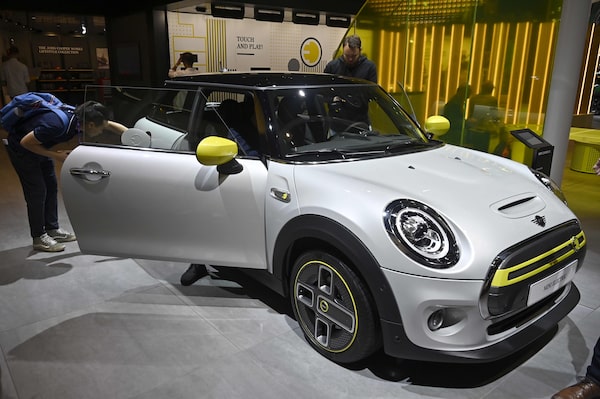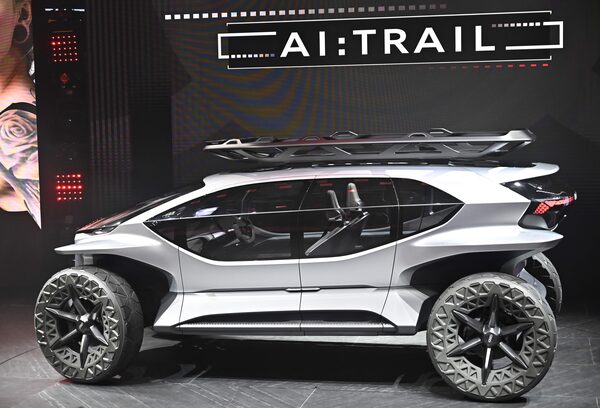
Mini used the Frankfurt show to finally unveil its first proper production-ready electric vehicle.TOBIAS SCHWARZ/AFP/Getty Images
There’s a whiff of desperation in the air at Europe’s biggest car show. As automakers at the International Motor Show (IAA) in Frankfurt whip the sheets off next year’s supposedly game-changing vehicles, it’s clear they’re trying harder to win over new customers.
“First, this IAA – and the social and political environment – are very different from previous events,” said Bernhard Mattes, president of the German Association of the Automotive Industry, in a news conference ahead of the show.
It’s not just because of Trump’s trade wars, declining vehicle sales across the world, Brexit, the pressure of meeting the Paris climate targets, the financial strain of big investments in electric and autonomous technology or even the protesters planning to block entrances to the auto show in the coming days – it’s all of the above. It all adds up to a rocky road ahead for the car business.
As a driver, this is the reason you’ll see an odd mix of new vehicles in showrooms next year as car companies hedge their bets. At one end of the dealership, you’ll see automakers playing it safe, hawking a fresh range of aggressive, sporty SUVs. At the other end, you’ll see those same automakers trying to stake out the moral high ground with new electric vehicles.
Electric ambition
Volkswagen has much to prove after its emissions cheating scandal. The company is trying to do a pivot to electric and go green. Of course, actions speak louder than advertisements. The first meaningful step in the company’s new direction is the launch of the compact ID.3, an affordable, purpose-built electric hatchback. There will be three versions, with driving ranges from roughly 300 to 500 km. VW’s factory in Germany will be able to churn out 330,000 electric cars per year by 2021.
There will be three versions of Volkswagen's ID.3, with driving ranges from roughly 300 to 500 km.JOE WHITE/Reuters
There’s no Canadian price yet, nor even a confirmed plan to sell it in North America. “We are considering the opportunity such a vehicle might bring for our market,” a spokesperson for VW Canada said. In other words, it may arrive eventually, but not next year. If VW wants to put Dieselgate in the rear-view and create an “e-car for the millions, not just millionaires,” as the company claims, it will need to put the ID.3 on sale in North America at a price that undercuts rivals.
Mini used the Frankfurt show to finally unveil its first proper production-ready electric vehicle. They’ll start rolling out of the factory later this year. Its range and performance aren’t exactly class-leading; the company estimates 235 to 270 km of range and acceleration from 0-100 km/h in 7.3 seconds. It won’t win over Tesla fans, but if it’s priced right, it could tempt returning Mini customers out of gas-powered machines.
Audi’s luxurious E-tron electric SUV is still brand new, but the company is already launching a follow-up. The new E-tron Sportback shares the same drivetrain – so you can expect a similar 329 km range – but features a sleeker-looking fastback shape. Same car, different clothes. It will be in showrooms next year, with a sky-high price near $100,000.

Audi's AI:Trail is an electric SUV concept with a cabin-forward design that maximizes space in a high-tech, loungelike interior.TOBIAS SCHWARZ/AFP/Getty Images
More ambitious from Audi is the AI:Trail, a clever electric SUV concept with a cabin-forward design that maximizes space in a high-tech, loungelike interior. It could preview an electric off-roader, but don’t expect it in showrooms any time soon.
Mercedes and Hyundai also showed off interesting electric concepts. The Mercedes Vision EQS is an advance look at an upcoming electric luxury sedan, a more eco-friendly alternative to the company’s flagship S Class.
Hyundai’s 45 concept was a surprise highlight at the show. The compact all-electric hatchback evokes the brand’s first car – the prosaic Pony – but updates its styling for a sleek Blade Runner-style future. Its simple, boxy lines and hard edges offer a modern take on ‘80s nostalgia. If Hyundai knows what’s good for it, the company should green-light this concept for production as soon as possible.
The Mercedes Vision EQS is an advance look at an upcoming electric luxury sedan.RALPH ORLOWSKI/Reuters
More of the same
Gasoline is still the fuel of choice for most drivers, and that’s not going to change in the next model year. Despite the focus on EVs at this auto show, car companies are still very much committed to selling profitable, gas-hungry SUVs and performance cars. There will be no shortage of these in 2020.
Land Rover is looking to the past for salvation. The iconic Defender is the SUV that launched the brand, and next year it’s finally making a return to Canada. Back in the 1950s, the original Defender was little more than a wartime Jeep with a British accent. Land Rover is eager to prove the 2020 model is just as rugged as the original, despite the fact that the new Defender is a family-friendly luxury ute. It will come in two and four-door models with seating for up to seven people. The design looks a little soft compared to the square-jawed, ruggedly handsome original, but we have no doubt this practical new SUV with a famous name will find many happy customers.

The new Land Rover Defender will come in two and four-door models with seating for up to seven people.DANIEL ROLAND/AFP/Getty Images
BMW and Mercedes are also launching aggressively-styled new SUVs of their own. The mid-size BMW X6 is a fastback version of the latest X5 SUV. The Mercedes GLE Coupe is, of course, not actually a coupe, but rather a fastback interpretation of the mid-size GLE SUV. Which of those two German juggernauts you prefer will likely come down to brand loyalty. Elsewhere on the Mercedes show floor was a new entry-level three-row SUV, the GLB. How exactly Mercedes crammed seven seats into this tiny thing we’re not sure, however the third row is strictly for children, or very short yoga enthusiasts.
Audi used the Frankfurt show to boost the Audi Sport sub-brand, the one responsible for the high-performance RS models. It’s out to prove it belongs in the same breath as BMW M and Mercedes-AMG. The all-new RS7 fastback sedan should please those with deep pockets and a need for speed. It has all-wheel drive, room for the whole family and 600 horsepower from an updated twin-turbo V-8. Rumour has it the RS6 uber-wagon, which shares the same engine, may finally come to Canada to challenge Mercedes’ mighty E63.
Last but not least, there will be a bumper crop of supercars next year.
Ferrari took the roof off two of its most popular cars. The mid-engine F8 and front-engine 812 Superfast are both now available as convertibles.

The Sian supplements its V-12 engine with an electric motor that draws power from a supercapacitor instead of a more traditional lithium-ion battery.TOBIAS SCHWARZ/AFP/Getty Images
Lamborghini finally caved and added a mild-hybrid system to one of its supercars. The Sian supplements its V-12 engine with an electric motor that draws power from a supercapacitor instead of a more traditional lithium-ion battery. The result is 808 horsepower and 0-100 km/h in under 2.8 seconds.
To celebrate the fact a modified Chiron recently became the first supercar to officially break the 300 mph (483 km/h) barrier, Bugatti unveiled a limited edition Chiron Super Sport 300+. It shares the bodywork and engine of that record-breaking car, and despite the fact there’s almost nowhere on earth you can drive that fast, the $5-million-dollar special edition is sure to sell out. Clearly the tumultuous social and political environment hasn’t put a damper on billionaires’ appetite for automotive exotica.
Shopping for a new car? Check out the new Globe Drive Build and Price Tool to see the latest discounts, rebates and rates on new cars, trucks and SUVs. Click here to get your price.
Stay on top of all our Drive stories. We have a Drive newsletter covering car reviews, innovative new cars and the ups and downs of everyday driving. Sign up today.